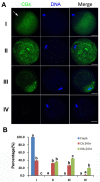Caffeine delays oocyte aging and maintains the quality of aged oocytes safely in mouse
- PMID: 28206974
- PMCID: PMC5400529
- DOI: 10.18632/oncotarget.15292
Caffeine delays oocyte aging and maintains the quality of aged oocytes safely in mouse
Abstract
Caffeine, as an oocyte aging inhibitor, was used in many different species to control or delay oocyte aging. However, the safety of caffeine and developmental competence of aged oocytes inhibited by caffeine has not been studied systematically. So we detected the spindle morphology, distribution of cortical granules, zona pellucida hardening and pronucleus formation to assess oocyte quality of caffeine treated oocytes. We found that aged oocytes treated by caffeine maintained weak susceptibility to activating stimuli and regained normal competent after aged further 6 hr. Caffeine maintained the spindle morphology, changed cortical granules distribution of aged oocytes and could not prevent zona pellucida hardening. Furthermore, caffeine increased pronucleus formation of aged oocytes and decreased fragmentation after fertilization. These results suggested that caffeine could maintain the quality of aged oocytes safely in mouse.
Keywords: Gerotarget; caffeine; mouse; oocyte aging; oocyte quality.
Conflict of interest statement
The authors declare no competing financial interests.
Figures




References
-
- Wang Q, Sun QY. Evaluation of oocyte quality: morphological, cellular and molecular predictors. Reproduction, fertility, and development. 2007;19:1–12. - PubMed
-
- Austin CR. In: In “concepts of development “. Whittaher J R, editor. Sinauer Associates Inc; 1974. Publisher.
-
- Ono T, Mizutani E, Li C, Yamagata K, Wakayama T. Offspring from intracytoplasmic sperm injection of aged mouse oocytes treated with caffeine or MG132. Genesis. 2011;49:460–471. - PubMed
-
- Goud P, Goud A, Van Oostveldt P, Van der Elst J, Dhont M. Fertilization abnormalities and pronucleus size asynchrony after intracytoplasmic sperm injection are related to oocyte postmaturity. Fertil Steril. 1999;72:245–252. - PubMed
-
- Kikuchi K, Izaike Y, Noguchi J, Furukawa T, Daen FP, Naito K, Toyoda Y. Decrease of histone H1 kinase activity in relation to parthenogenetic activation of pig follicular oocytes matured and aged in vitro. Journal of reproduction and fertility. 1995;105:325–330. - PubMed
MeSH terms
Substances
LinkOut - more resources
Full Text Sources
Other Literature Sources
Medical

